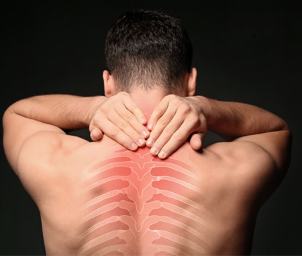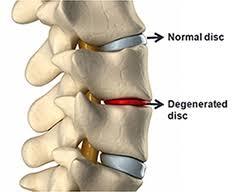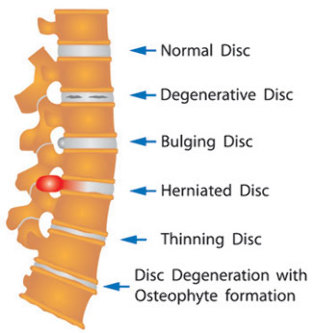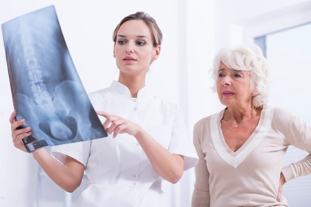
The disease osteochondrosis is the most common disease of all diseases of the spine. As well as low back pain, directly, it's a burned-degenerative defeat of the disks, are located between the vertebrae, as a result of this leads to irreversible changes in the structure, and even the shape of the disks themselves.
With the increase of age, the man these changes in his spine grow more and more, and at the age of about 40...45 years osteochondrosis sick almost all. In and of itself osteochondrosis of the spine develops very less compared to, for example, the lumbar or cervical areas of the spine, as well as the vertebrae in it is much less mobile, which in other vertebrates areas. In addition, the area of the back in the chest area has the most developed corset muscle, the support staff of the thoracic spine is much better than in others.
What is this to the thoracic back pain?
Thoracic back pain is directly a beam of the discs between the vertebrae, with the concomitant reduction of thickness and, consequently, followed due to crushing of the nerve endings that are found in the pain in the chest area of a man.
However, once again, please note that, due to the fact that physiological mounting lugs of a person is quite stiff, the department of the spinal column in the region of the breast, the less susceptible to the disease osteochondrosis.
Usually in this process of malocclusion involved the discs between the vertebrae of the department of maternal, which includes twelve thoracic vertebrae. But more often, osteochondrosis of the department of maternal pathological changes occur in Wernigerode the vertebrae. There are different degrees of lesion in breast osteochondrosis, and then we will consider them in more detail.
Predisposing factors to the development of breast degenerative disc disease
The exact causes of osteoarthritis the department of modern science until the end until they are installed. For the time being has decided to allocate in the medicine the following predisposing factors, or the so-called risk factors:
- hereditary predisposition;
- excessive physical activity;
- injuries of the spine, such as, for example, the fall or injury;
- the changes that occur with age, intervertebral discs, and the consequent reduction in hydration of the tissue disks;
- circulatory disorders in the area of the chest.
The causes that contribute to the disease osteochondrosis of the vertebral column
The basis of the degree of development of the disease osteochondrosis, in general, promotes the lack of physical exercise, that is, lack of muscle loads, leading to a weakening of the functions of the corset of muscle and, consequently, to an increase in load on the intervertebral discs, and ligaments.
In other, more factors of developing osteoarthritis are:
- subcooling of the body;
- the presence of chronic stress situations;
- transferred the infection;
- heavy physical working conditions;
- resulting hormonal disturbances in the body;
- violation of the process of metabolism of the body;
- the presence of congenital malformations of the vertebral column.
In the course of an impact of all of these factors, or even sometimes one of the discs between the vertebrae with the passage of time will develop burnt-degenerative, irreversible processes:
- purposee the nucleus of the intervertebral disc gradually begins to lose the fluid that is responsible for the lubrication of functions, that is, in the final analysis, it greatly reduces the strut spring, the function of this disk;
- next, the fibrous ring widths the same vertebrae, due to the increase of the load on him, he becomes more vulnerable, which leads in turn, to its gradual destruction.

The symptoms are the arthritis and its signs
The clinical symptoms of the breast, degenerative disc disease completely depend on such factors as:
- the age of the patient;
- the extent of the defeat of the disease;
- phase of osteoarthritis of the spine: remission or aggravation.
The main signs of degenerative disc disease of the thoracic are:
- chest pain in the area of the spine, the so-called - Dorigo;
- lesion of the nerve endings of the spinal cord – radiculopathy;
- closure of the abdominal syndrome;
- a cardiac catheter is syndrome or changes in the cardiac muscle, characteristic pain, persistent even under the effect of nitroglycerin;
- pulmonary syndrome, in the form of stagnation in the lungs with signs of hypoxia, that is, of suffocation.
The increase of the temperature of the body of the patient during the breast-feeding osteochondrosis is not there, that is also direct differential sign diagnostic. Dorsalgia in the chest area indicates the presence of cracks in the fibrous ring widths and deformation of the pulposus of the kernel. During the development felt, the pain of this area of the chest that worsen.
In addition, the characteristic symptoms of breastfeeding degenerative disc disease with myelopathy, compressive, that is, the deformation of the nerve endings, are:
- the feeling of "tingling" - paresthesia;
- pain in the movement of an occlusion of the nerve;
- reduction of the temperature sensitivity and the contact;
- abnormalities in the spine and motor function.

Extent of disease breast osteochondrosis
Different degrees of disease breast osteochondrosis characterize each of his malocclusion, each of which has only the clinical signs. In modern medicine, there are four distinct degrees of degenerative disc disease of the chest, and, as a result, four periods of its development. Consider them more.
The first degree, for which the characteristic is that the inside of a ring of fibrous occur fractures, which subsequently penetrates purposee nucleus. This period of the development of the disease breast osteochondrosis is characterized by the following features:
- the appearance of pain in the spinal column in position his defeat, but do not go beyond the limits of the localization of the onset of the disease;
- specify the pain can wear, both of a permanent character, so as to be in the form of a cross;
- can occur seizure the contraction of the muscle, accompanied by pain in the heart area.
The second degree, as the period of development of the breast, degenerative disc disease, characterized by a pathological appearance of greater discal mobility with the following clinical manifestations:
- appear vertebral subluxations of the thoracic spine;
- the pain intensified during the movement;
- seems uncomfortable during a long period of continuous laying.
The third degreeis characterized by a period, when you break the fibrous ring widths and, with this, beyond it overlooks purposee nucleus. In this period of the disease osteochondrosis of the vertebral column began to appear in the hernia, the clinical signs that are quite heavy. That is to say, neuro-vascular, musculo-tonic and reflex-dystrophic.
Specified below, of the third grade of degenerative disc disease of the chest is a characteristic change of the following states of the vertebral column:
- moderate fixation of the provisions of the vertebral column;
- limitation of the mobility of the department, manifests itself in the form of kyphosis or scoliosis.
The fourth degree, related to that period, in which burned-a degenerative process that affects all the structures immersed in the vertebral column. In this pathological involved yellow, interspinal, and more beams and structures that surround the spinal column, occurs the non-fibrous. In this period of the disease breast osteochondrosis, clinically observed, so-called, the state of remission.
The complications that can occur during breastfeeding osteochondrosis
With further progression of the disease breast osteochondrosis, perhaps the development of accompanying complications, such as:
- the inflammation of the nerve endings to the spinal cord.
- aspect of the intervertebral hernias;
- the development of vascular dystonia;
- the development of hernia of vertices of schmorl;
- the disease spondylosis;
- pathological proliferation of bone outgrowths - osteophytes;
- a substantial reduction of the spinal canal.
It should be noted that the degree of severity, complications occur while breastfeeding osteochondrosis it all depends on the pace of progress of the process of situation of the disease, and, of course, by the efficiency of the methods of treatment of degenerative disc disease of the spine.

To diagnose osteoarthritis and its methods
In practice, we apply a series of methods to diagnose osteoarthritis. Of these the most common is the x-ray examination, the results of which are quite knowledgeable. The signs of the breast, degenerative disc disease, identified in this study, are:
- violated the contours of the discs between the vertebrae;
- edge epithelial lp purchased the wave nature;
- the intervertebral discs have changed its shape;
- arising osteophytes – bony pathological proliferation;
- increased and sharp hooked processes of the vertebrae;
- body the thoracic vertebrae changed his normal form;
- substantially reduced the size of the height of the discs between the vertebrae;
- formed hernia of a disk between the vertebrae.
In some cases it is practiced method to diagnose osteoarthritis by using radiopaque research, defines the following signs of this disease:
- in the case of execution of malocclusion contrast medium fills the disc between the vertebrae completely;
- with the help of a contrast medium, are visible the contours of the pulposus of the kernel, and wear the irregular nature;
- the destruction of the intervertebral disc, in large measure, a contrast, and penetrates beyond it, until the penetration into the spinal canal.
Treatment for osteoarthritis
Possession of treat osteoarthritis is perhaps one of the following methods are applied taking into account the diagnostic results of the breastfeeding degenerative disc disease, that is to say:
- conservative treatment traditional;
- treat osteoarthritis with the help of discharge;
- promptly surgery.
Nothing new, of course, here is not yet been invented, and as such treatment for osteoarthritis, called conservative, is now become a traditional for the treatment of any type of degenerative disc disease. In any case, it is preferable to always be conservative-medical treatment method for osteoarthritis through the assignment of nonsteroidal anti-inflammatory drugs aimed at relief of pain. It should be noted that these drugs very well eliminate the inflammatory processes, and also showed the swelling, helping to reduce the process of compression of the nerve roots. In more complex cases, maternal diseases osteochondrosis, the doctor may prescribe an additional number of drugs, for example, some powerful painkillers and muscle relaxants, which block the appearance of muscle spasms.
When the pain moves away or she managed to stop, that is, during the remission, is also assigned for physiotherapy treatment and, in addition, PHYSIOTHERAPY and massage. The main instrument of the fight, and prevention of this disease in the treatment of physiotherapy, magnetic therapy is through specific therapeutic tools.
In addition to the above, for the treatment of breast degenerative disc disease can be used with success and traction treatment, that is, the cure arthritis through the appropriate drain. With this method, paravertebral muscles, tissues and ligaments are stretching, which leads to an increase of the distance. Also and-a-half millimeters will already be enough to reduce the swelling, the size of the constriction, but also relieve the tension, adjacent to the spine muscles.
And, behold, surgery is only recommended when the above methods treat osteoarthritis does not give the desired result.




























